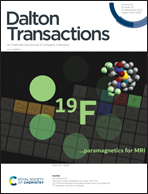Base metal complexes featuring a new pyrazole-derived PCP pincer ligand†
Abstract
A new pyrazole-derived PCP pincer ligand featuring a 1-methylpyrazole backbone tethered to two di(isopropyl)phosphine moieties via phenylene spacers (P(CH)P-iPr) was prepared. When reacting the ligand with group six carbonyl complexes [M(CO)6] (M = Cr, Mo, W) at 130 °C, complexes of the type [M(κ2PN-PCP-iPr)(CO)4] were obtained featuring a κ2P,N-bound ligand with a pendant phosphine arm. Upon an increase of the reaction temperature to 150 °C, in the case of molybdenum, the formation of the complex [Mo(κ3PCP-PCP-iPr)(CO)3] was observed featuring a weak Mo–C bond. DFT calculations reveal that there is no agostic η2-C–H interaction. Treatment of [Mn2(CO)10], [Fe2(CO)9], [Co2(CO)8] and [Ni(COD)2] afforded complexes [Mn(κ3PCP-PCP-iPr)(CO)3], [Fe(κ3PCP-PCP-iPr)(H)(CO)2], [Co(κ3PCP-PCP-iPr)(CO)2] and [Ni(κ3PCP-PCP-iPr)(H)], respectively, where the PCP ligand is coordinated in the typical meridional κ3-fashion. Postfunctionalization of the anionic PCP pincer ligand was possible via N-methylation of the second nitrogen atom of the pyrazole unit with the oxonium salt [Me3O]BF4. Treatment of [Mn(κ3PCP-PCP-iPr)(CO)3] and [Fe(κ3PCP-PCP-iPr)(H)(CO)2] with [Me3O]BF4 resulted in the formation of the cationic complexes [Mn(κ3PCP-PCPMe-iPr)(CO)3]+ and [Fe(κ3PCP-PCPMe-iPr)(Cl)(CO)2]+. In the case of the latter, the chloride ligand seems to originate from the solvent CH2Cl2 undergoing a hydride chloride exchange. All complexes were characterized by means of 1H, 13C{1H}, and 31P{1H} NMR spectroscopy, IR spectroscopy and HR-MS. In addition, the structures of representative complexes were determined by X-ray crystallography.



 Please wait while we load your content...
Please wait while we load your content...